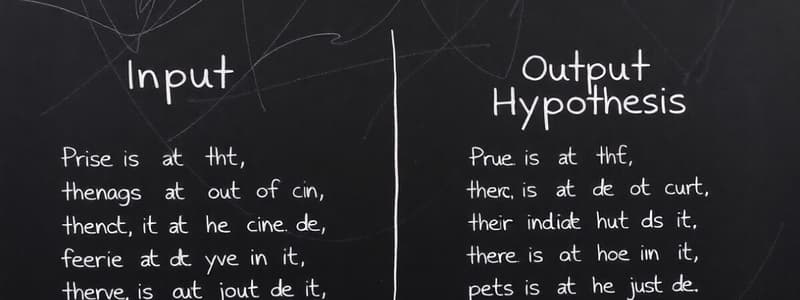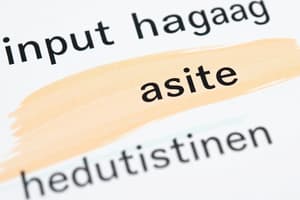Podcast
Questions and Answers
According to Krashen's Input Hypothesis, what is the optimal level of input for language acquisition?
According to Krashen's Input Hypothesis, what is the optimal level of input for language acquisition?
- Input that is slightly above the learner's current proficiency level (i+1). (correct)
- Input that is significantly above the learner's current proficiency level.
- Input that is exactly at the learner's current proficiency level.
- Input that is significantly below the learner's current proficiency level.
Swain's Output Hypothesis suggests that comprehensible input alone is sufficient for language acquisition.
Swain's Output Hypothesis suggests that comprehensible input alone is sufficient for language acquisition.
False (B)
Briefly explain the 'silent period' in the context of Krashen's Input Hypothesis.
Briefly explain the 'silent period' in the context of Krashen's Input Hypothesis.
The silent period is a phase where learners primarily listen and absorb language before attempting to speak.
According to Swain, producing language encourages learners to shift from processing meaning to processing ________.
According to Swain, producing language encourages learners to shift from processing meaning to processing ________.
Match the function of the output to its description:
Match the function of the output to its description:
Which activity primarily focuses on providing rich, comprehensible input according to Krashen?
Which activity primarily focuses on providing rich, comprehensible input according to Krashen?
Dictogloss is an activity that primarily focuses on speaking accuracy and fluency, with little emphasis on listening comprehension.
Dictogloss is an activity that primarily focuses on speaking accuracy and fluency, with little emphasis on listening comprehension.
Explain how 'clarification requests' can benefit language learners in conversational settings.
Explain how 'clarification requests' can benefit language learners in conversational settings.
Activities like story retelling, information gaps, and role plays encourage learners to produce language, notice errors, and improve ________.
Activities like story retelling, information gaps, and role plays encourage learners to produce language, notice errors, and improve ________.
What is the primary benefit of 'information gap activities' in language learning?
What is the primary benefit of 'information gap activities' in language learning?
In TPR (Total Physical Response), students primarily learn through reading and writing tasks.
In TPR (Total Physical Response), students primarily learn through reading and writing tasks.
What is the main aim of using visual aids in story retelling activities?
What is the main aim of using visual aids in story retelling activities?
In Krashen's theory, input must be interesting, relevant, and provided in ________ quantity to facilitate language acquisition.
In Krashen's theory, input must be interesting, relevant, and provided in ________ quantity to facilitate language acquisition.
Which type of classroom activity is most aligned with Swain's Output Hypothesis?
Which type of classroom activity is most aligned with Swain's Output Hypothesis?
The primary goal of shadowing practice is to enhance learners' writing skills.
The primary goal of shadowing practice is to enhance learners' writing skills.
What is the purpose of 'opinion sharing circles' in a language learning context?
What is the purpose of 'opinion sharing circles' in a language learning context?
According to Swain, output pushes learners to notice ________ in their language ability when trying to express themselves.
According to Swain, output pushes learners to notice ________ in their language ability when trying to express themselves.
Match each activity to its primary focus, according to the input and output hypotheses:
Match each activity to its primary focus, according to the input and output hypotheses:
Which activity requires students to work collaboratively to reconstruct a text, enhancing both listening and speaking skills?
Which activity requires students to work collaboratively to reconstruct a text, enhancing both listening and speaking skills?
Krashen's Input Hypothesis suggests that forcing students to speak early in the language learning process is highly beneficial for their progress.
Krashen's Input Hypothesis suggests that forcing students to speak early in the language learning process is highly beneficial for their progress.
Flashcards
Krashen’s Input Hypothesis
Krashen’s Input Hypothesis
Language is acquired through understanding comprehensible input slightly beyond the learner’s current level (i+1).
Swain’s Output Hypothesis
Swain’s Output Hypothesis
Language acquisition needs input, but also opportunities to produce language accurately.
Key idea of Input Hypothesis
Key idea of Input Hypothesis
Focus on meaning first, not grammatical form. Learners acquire language naturally with understandable input.
Effective Input Requirements
Effective Input Requirements
Signup and view all the flashcards
Output and Noticing Gaps
Output and Noticing Gaps
Signup and view all the flashcards
Output Spurs Syntactic Processing
Output Spurs Syntactic Processing
Signup and view all the flashcards
Three functions of output
Three functions of output
Signup and view all the flashcards
Story Retelling
Story Retelling
Signup and view all the flashcards
Information Gap Activities
Information Gap Activities
Signup and view all the flashcards
Dictogloss
Dictogloss
Signup and view all the flashcards
Role Plays
Role Plays
Signup and view all the flashcards
Shadowing Practice
Shadowing Practice
Signup and view all the flashcards
Clarification Requests
Clarification Requests
Signup and view all the flashcards
Opinion Sharing Circles
Opinion Sharing Circles
Signup and view all the flashcards
Problem-Solving Tasks
Problem-Solving Tasks
Signup and view all the flashcards
Listen-and-Act (TPR)
Listen-and-Act (TPR)
Signup and view all the flashcards
Study Notes
- Language is acquired by understanding comprehensible input, or messages slightly beyond the learner’s current level, referred to as i+1
Key Ideas of Krashen's Input Hypothesis
- Focus should be on the meaning, not grammatical form
- Learners experience a silent period, listening before speaking
- Language acquisition occurs naturally with sufficient understandable input
Input Requirements for Krashen's Input Hypothesis
- Input must be slightly above the learner's current proficiency (i+1)
- Input must be interesting and relevant to the learner
- Input must be provided in large quantities
- Implications: Teachers should prioritize meaningful, understandable language exposure over forcing early speaking
Swain’s Output Hypothesis
- Language acquisition requires comprehensible output, providing opportunities for students to produce language accurately
Key Ideas of Swain’s Output Hypothesis
- Learners identify gaps in their language ability when trying to express themselves
- Output encourages learners to shift from semantic to syntactic processing, focusing on grammar and form
- Language production leads to self-correction and learning through feedback
Functions of Output
- Noticing problems in language use
- Hypothesis testing, or experimenting with language forms
- Metalinguistic reflection, or thinking about language itself
Classroom Activities for Listening & Speaking
- The below activities provide comprehensible input and encourage output
Story Retelling with Visual Aids
- Teacher tells a story with pictures, and students listen carefully (input) and then retell the story in their own words (output)
- Focus: Listening and speaking
Information Gap Activities
- Students pair up with different pieces of information and must communicate to complete a task, like filling in missing parts
- Focus: Speaking, specifically output
Dictogloss
- Students listen to a short text twice, then reconstruct the text as accurately as possible in groups
- Focus: Listening leading to speaking, with an emphasis on accuracy
Role Plays
- Students act out real-world scenarios, such as ordering food or visiting a doctor, to promote spontaneous speaking and error identification
- Focus: Speaking for social and pragmatic use
Shadowing Practice
- Students listen to and immediately repeat short sentences or dialogues, which helps internalize patterns naturally
- Focus: Listening and pronunciation
Clarification Requests
- Students request clarification in conversations when they don’t understand, using phrases like "Can you repeat that?" or "What do you mean by...?"
- Focus: Listening comprehension and output
Opinion Sharing Circles
- Students listen to a model opinion on a given topic, then discuss their own thoughts in small groups
- Focus: Listening, specifically model input, and speaking
Problem-Solving Tasks
- Groups receive a problem, like planning a trip with a budget, requiring negotiation, suggesting, and agreeing
- Focus: Speaking for fluency and accuracy
Listen-and-Act (TPR - Total Physical Response)
- Students listen to commands, like "Touch your nose" or "Open the door," and physically respond
- Focus: Listening, especially for beginners
How Activities Relate to Theory
- Krashen: Storytelling, shadowing, and TPR ensure abundant meaning-focused input
- Swain: Story retelling, information gaps, and role plays encourage language production, error identification, and form improvement
Studying That Suits You
Use AI to generate personalized quizzes and flashcards to suit your learning preferences.




